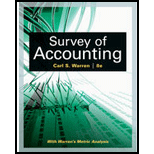
Concept Introduction:
Quick Ratio: Quick ratio is the ratio of quick assets with current liabilities it tells about the liquidity of the company/ business. Best possible quick ratio is 1:1.
Requirement-1:
To Calculate:
Working capital, current ratio and quick ratio.
Concept Introduction:
Working Capital: It is the difference between the current assets and the current liabilities of the business. Working capital is the amount which is used by the business to meet its short term expenses.
Current Ratio: Current ratio is the ratio of current assets with current liabilities it tells about the how much company strong to meet its day to day expenses. Best current ratio is 2:1.
Quick Ratio: Quick ratio is the ratio of quick assets with current liabilities it tells about the liquidity of the company/ business. Best possible quick ratio is 1:1.
Requirement-2:
To Indicate:
What Conclusion from above ratios?
Trending nowThis is a popular solution!

Chapter 9 Solutions
Bundle: Survey of Accounting, Loose-Leaf Version, 8th + CengageNOWv2, 1 term Printed Access Card
- I am looking for the correct answer to this accounting question with appropriate explanations.arrow_forwardI am searching for the accurate solution to this financial accounting problem with the right approach.arrow_forwardI am looking for the correct answer to this general accounting problem using valid accounting standards.arrow_forward
- Hello tutor please given General accounting question answer do fast and properly explain all answerarrow_forwardChalmers Corporation operates in multiple areas of the globe, and relatively large price changes are common. Presently, the company sells 110,200 units for $50 per unit. The variable production costs are $20, and fixed costs amount to $2,079,500. Production engineers have advised management that they expect unit labor costs to rise by 10 percent and unit materials costs to rise by 15 percent in the coming year. Of the $20 variable costs, 25 percent are from labor and 50 percent are from materials. Variable overhead costs are expected to increase by 20 percent. Sales prices cannot increase more than 12 percent. It is also expected that fixed costs will rise by 10 percent as a result of increased taxes and other miscellaneous fixed charges. The company wishes to maintain the same level of profit in real dollar terms. It is expected that to accomplish this objective, profits must increase by 8 percent during the year. Required: Compute the volume in units and the dollar sales level…arrow_forwardAfter describing a threat/risk in either the revenue cycle (i.e., in sales and cash collection activities) or the expenditure cycle (i.e., in purchases or cash disbursement activities). What are specific internal controls that might be applied to mitigate each of the threats we've identified?arrow_forward
 Survey of Accounting (Accounting I)AccountingISBN:9781305961883Author:Carl WarrenPublisher:Cengage Learning
Survey of Accounting (Accounting I)AccountingISBN:9781305961883Author:Carl WarrenPublisher:Cengage Learning Financial AccountingAccountingISBN:9781337272124Author:Carl Warren, James M. Reeve, Jonathan DuchacPublisher:Cengage Learning
Financial AccountingAccountingISBN:9781337272124Author:Carl Warren, James M. Reeve, Jonathan DuchacPublisher:Cengage Learning College Accounting, Chapters 1-27AccountingISBN:9781337794756Author:HEINTZ, James A.Publisher:Cengage Learning,
College Accounting, Chapters 1-27AccountingISBN:9781337794756Author:HEINTZ, James A.Publisher:Cengage Learning, Managerial AccountingAccountingISBN:9781337912020Author:Carl Warren, Ph.d. Cma William B. TaylerPublisher:South-Western College PubCentury 21 Accounting Multicolumn JournalAccountingISBN:9781337679503Author:GilbertsonPublisher:Cengage
Managerial AccountingAccountingISBN:9781337912020Author:Carl Warren, Ph.d. Cma William B. TaylerPublisher:South-Western College PubCentury 21 Accounting Multicolumn JournalAccountingISBN:9781337679503Author:GilbertsonPublisher:Cengage Financial And Managerial AccountingAccountingISBN:9781337902663Author:WARREN, Carl S.Publisher:Cengage Learning,
Financial And Managerial AccountingAccountingISBN:9781337902663Author:WARREN, Carl S.Publisher:Cengage Learning,





